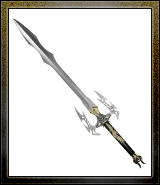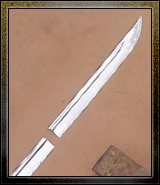 |

Introduction
Decorative swords are a very popular item in present day homes. Pieces ranging from Japanese Samurai swords to European broadswords can be found displayed on walls, tables, and atop bookshelves in homes all around the world. Swords are also commonly found in the basement or your closet where your wife says that all “your stupid crap belongs”. This weapon is easy to find and can usually be bought for about $20 and up.
Functionality [4/10]
|
 |
|
A Decorative Sword
|
The sword is one of those weapons that can either help or a hinder you. The main attack with a sword is a swipe or stab, both of which are pretty useless against a zombie, but we'll cover that later. The type of sword you have changes the effectiveness of the weapon. For example, your decorative $20 stainless steel blade is about as useful as a sword as a cinder block is as a running shoe. Decorative swords generally do not come sharpened, and stainless steel does not hold an edge well at all and will dull very quickly, which will make severing heads nearly impossible. Also stainless steel swords were not meant for battle as they are brittle and poorly constructed, and will most likely break after a few good whacks. A high carbon steel sword forged for reenactment fighting (SCA) would be a better choice. The high carbon steel that it is constructed from will allow it to hold an edge for a decent amount of time, and unlike stainless steel, which is very hard and brittle, high carbon steel will be able to withstand a good beating.
Effectiveness [5/10]
The sword relies primarily on a cleaving attack to cut your attacker, hopefully lopping off limbs or best case scenario, heads. Cutting a zombie is fairly useless, it does not hurt them. Cuts also spray blood and other bodily fluids everywhere which you will be in close proximity to. These fluids could be ingested or absorbed and then you too will become a zombie. When swinging or swiping at a zombie, the most effective way would be to aim for the head. The sharpened edge of the blade combined with the blunt force associated with the impact is usually sufficient to rupture the skull and dispatch a zombie. Stabbing again, is fairly useless. As mentioned before, ZOMBIES DON'T FEEL PAIN!!! If you stab them in the chest or anywhere else, they will probably just keep walking, running themselves through to the hilt or guard of your sword, and then bite you. When stabbing a zombie, the most effective way would be to go right through the eye socket into the brain, although such a strike is hard and requires practice. You may get lucky but don't rely on this. Unfortunately, the effectiveness of a sword will rely on the quality of the weapon and the skill of the person wielding it. A sword is a weapon that can be picked up and used with relative ease but the skill that goes behind it takes a lifetime to master. An inexperienced wielder will tire quickly and the strikes will most likely be ineffective. In the hands of a practiced swordsman, the attacks would be more effective, although you would still be within the “spray zone” and susceptible to infection. Also, the sword is not very useful when fending off large numbers of zombies and is really only effective against groups of 3 or less, but it is a silent weapon and will not draw the attention of nearby zombies as a gun shot might.
Durability [5/10]
|
 |
|
A snapped stainless steel
blade
|
The durability of a sword can vary greatly depending on a number of factors. Decorative stainless steel swords have a very short life expectancy. Stainless steel is very hard and brittle. Having a hard sword may sound good in theory but it is in fact the exact opposite. Stainless steel has little give or bend to it, meaning if struck improperly, one of two things will most likely happen, either the weapon will bend or crease and remain that way; even if the sword is repaired, it will have a weak point which will pose a danger to you with every swing. Or, the blade will outright snap, leaving you defenseless. A high carbon or spring-steel blade is made to put up with the abuse or repeated impacts and will have a much lower chance of breaking.
Portability [7/10]
With a sheath the sword is highly portable and can be worn on your hip or back for quick accessibility. Sheaths can be easily made from a variety of materials including leather, cloth, metal, and wood. Decorative swords were designed for display and not for use, so they are often improperly balanced with overly thick heavy blades (mostly to help prevent them from breaking), and little to no counter weight on the pommel. This unfortunately tires out your arm quickly during extended use or carrying. Decorative swords also tend to have extraneous material on them (over-sized grips, guards, impractically wide and/or thick blades, spikes, skulls, jewels, etc) to add to their visual appeal. This adds excess weight, making most decorative swords weigh anywhere from 3 to 15 pounds (1.36 to 3.63 kg). This is in NO WAY historically accurate with period swords, and modern day reproduction swords weighing between 1 to 5 pounds (0.45 to 2.27 kg); 5 pounds being an exceptionally heavy sword for the day.
Practicality [4/10]
Although this weapon is capable of causing deadly damage, it is more of a prop or toy than anything else, and will likely do more harm than good. If you are using one of these decorative stainless steel swords (unsharpened or even sharpened) it should be used as a last resort weapon or a first-thing-I-could-grab weapon until you can pick up something sturdier.
|
 |